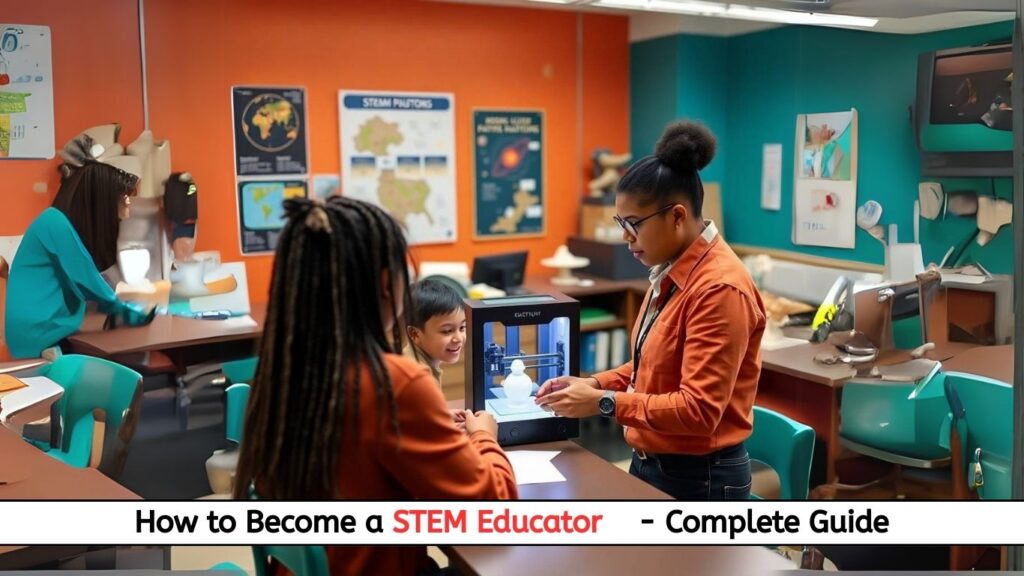
Introduction
In an era driven by technological advancement, STEM (Science, Technology, Engineering, and Mathematics) Educators are shaping the innovators of tomorrow. From K-12 classrooms to corporate training programs, these professionals inspire critical thinking, problem-solving, and creativity in students of all ages.
This comprehensive guide covers:
✅ History of STEM Education
✅ Salary Expectations (Schools, Universities, Corporate)
✅ Roles & Responsibilities
✅ Essential Qualifications & Skills
✅ How to Get Started (Step-by-Step)
✅ Future Trends & Job Outlook
Let’s explore this dynamic and impactful career!
1. The History of STEM Education
Early Foundations (Pre-20th Century)
- Ancient Civilizations: Early STEM concepts emerged in Egyptian mathematics, Greek engineering, and Chinese inventions.
- Industrial Revolution (18th-19th Century): The need for technical skills in engineering and mechanics grew.
20th Century: The Birth of Modern STEM
- 1950s-60s: The Space Race between the U.S. and USSR accelerated STEM education.
- 1980s-90s: Computer science entered school curricula as PCs became mainstream.
- 2001: The term “STEM” was coined by the National Science Foundation (NSF).
21st Century: The STEM Boom
- 2010s: Governments worldwide prioritized STEM to fill tech talent gaps.
- 2020s: AI, robotics, and coding became essential in K-12 education.
Today, STEM educators are in high demand across schools, universities, and corporate training programs.
2. STEM Educator Salary Expectations
Salaries vary by education level, experience, and sector:
| Experience Level | Average Salary (Annual) |
|---|---|
| K-12 Teachers | $45,000 – $85,000 |
| Community College Instructors | $50,000 – $90,000 |
| University Professors | $70,000 – $150,000+ |
| Corporate STEM Trainers | $60,000 – $120,000 |
| Freelance/Online STEM Tutors | $30 – $100/hour |
Top-Paying STEM Fields
✔ Computer Science & Coding ($70K – $130K)
✔ Engineering (Robotics, Aerospace) ($80K – $150K)
✔ Biotechnology & Medical Sciences ($75K – $120K)
✔ Data Science & AI ($90K – $160K)
Note: Private schools, tech companies, and government research labs offer higher salaries.
3. Roles & Responsibilities of a STEM Educator
STEM educators do more than teach—they inspire innovation. Key responsibilities include:
A. Curriculum Development
- Design hands-on, project-based lessons (e.g., robotics labs, coding challenges).
- Align coursework with Next Generation Science Standards (NGSS) or Common Core.
B. Classroom & Lab Instruction
- Teach STEM subjects (math, physics, computer science, engineering).
- Conduct experiments, simulations, and hackathons.
C. Student Mentorship
- Guide students in science fairs, robotics competitions, and coding bootcamps.
- Encourage girls and underrepresented groups to pursue STEM careers.
D. Technology Integration
- Use 3D printers, VR labs, and AI tools (e.g., ChatGPT for coding help).
- Teach programming languages (Python, Scratch, JavaScript).
E. Professional Development
- Stay updated on emerging STEM trends (quantum computing, CRISPR).
- Attend workshops (NASA STEMinars, MIT Edgerton Center).
4. Qualifications & Skills Required
A. Educational Background
- K-12 Teachers: Bachelor’s in Education + STEM field (e.g., Math, Biology).
- Professors/Trainers: Master’s or Ph.D. in STEM discipline.
- Certifications:
- Teaching License (state-required for public schools).
- STEM.org Certified Educator.
- Google Certified Educator (for tech integration).
B. Technical Skills
✔ Coding & Robotics (Arduino, Raspberry Pi, LEGO Mindstorms)
✔ Data Analysis (Excel, Python, R)
✔ EdTech Tools (Kahoot!, Labster, Tinkercad)
C. Soft Skills
✔ Problem-Solving & Creativity
✔ Patience & Adaptability (for different learning styles)
✔ Passion for Lifelong Learning
5. How to Get Started as a STEM Educator
Step 1: Build a Strong STEM Foundation
- Earn a degree in a STEM field + education (e.g., BS in Math + Teaching Credential).
- Take free online courses (Coursera’s “STEM Teaching” or edX’s “Teaching Coding”).
Step 2: Gain Teaching Experience
- Volunteer at after-school STEM clubs (FIRST Robotics, Girls Who Code).
- Tutor students in math, science, or programming.
Step 3: Get Certified
- Obtain a state teaching license (for K-12 roles).
- Earn micro-credentials (IBM’s AI Education, Microsoft’s Hacking STEM).
Step 4: Apply for Jobs
- Job Titles to Target:
- STEM Teacher (K-12)
- College Lecturer (Engineering, CS)
- Corporate Technical Trainer
- Museum Science Educator
Step 5: Network & Grow
- Join STEM organizations (NSTA, CSTA, IEEE).
- Present at conferences (ISTE, STEMconnector).
6. Future of STEM Education
Emerging Trends
🚀 AI & Machine Learning in Classrooms (ChatGPT tutors, personalized learning).
🚀 Virtual Labs & AR/VR Science Simulations (e.g., Labster’s virtual biology labs).
🚀 Space & Climate Science Education (NASA collaborations, green tech).
🚀 Coding for All Ages (Elementary school Python courses).
Job Outlook
- 8-10% growth for STEM teachers by 2030 (faster than average).
- High demand for computer science and engineering educators.
Final Thoughts: Is STEM Education Right for You?
This career is perfect if you:
✓ Love science, tech, or math
✓ Enjoy mentoring future innovators
✓ Want to shape the next generation of problem-solvers
Pro Tip: Specialize in high-demand areas (AI, cybersecurity, renewable energy) for career growth.
Ready to Inspire the Next Einstein or Musk?
📌 Comment below for free STEM teaching resources!
📌 Share this guide with aspiring educators!













Post Comment